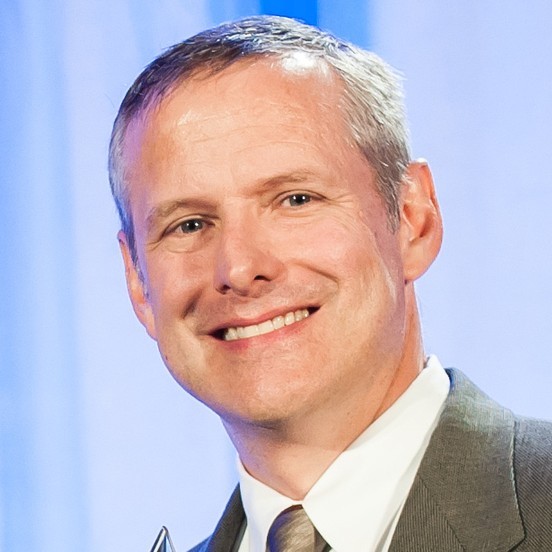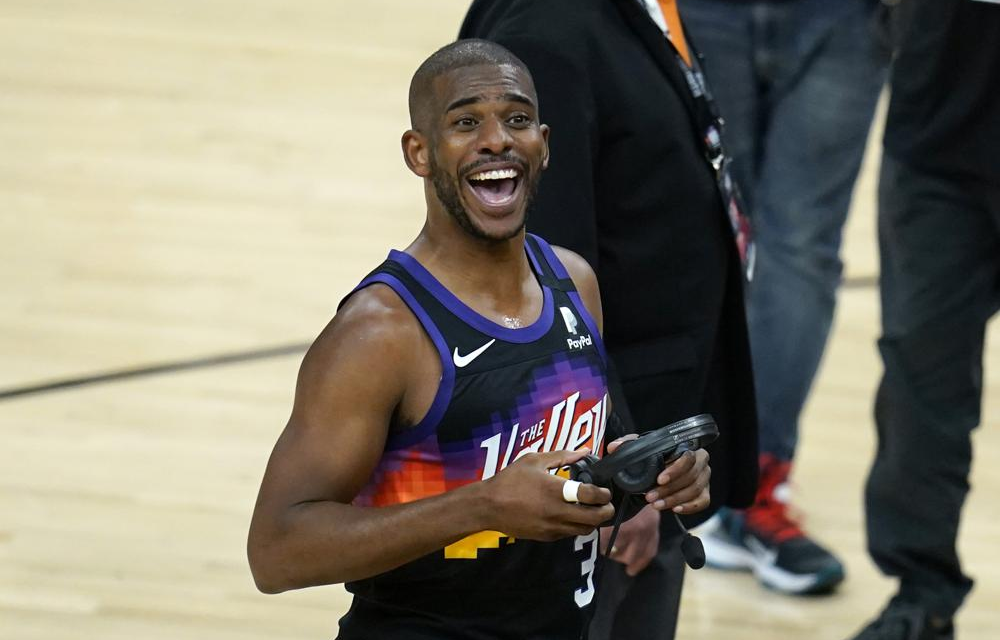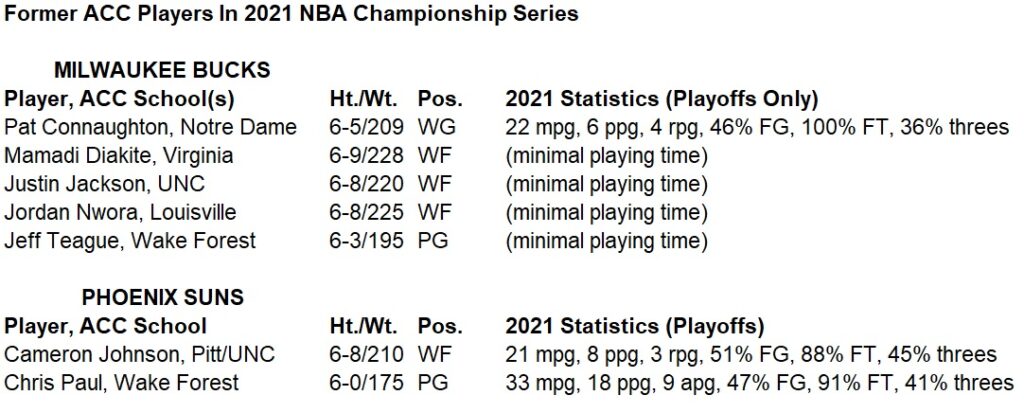
As Chris Paul Nears His First NBA Title – After 16 Years and Five Pro Franchises – He Still Remembers His First Team
By David Glenn
Chris Paul played two seasons of varsity basketball at West Forsyth High School in Clemmons, N.C., two seasons in the ACC at Wake Forest, and is now a 16th-year professional, with his fifth franchise, within reach of his first NBA championship.
His “first team,” though, was the North Carolina Tar Heels.
“Since I was a little kid, (UNC) was the only team I wanted to play for,” Paul said. “All the way into my junior year of high school, when I took a recruiting visit to Chapel Hill, that was still where I wanted to go.”
When the 36-year-old Phoenix Suns’ superstar point guard is introduced tonight before Game 2 of the NBA Finals, of course, he’ll be battling the Milwaukee Bucks as a collegiate representative of Wake Forest, not Carolina.
“We’ll never know what might have been, and that’s OK,” Paul said. “I’m just proud to represent my family, proud to represent Lewisville (his hometown, near Winston-Salem), proud to represent Wake Forest, proud to represent my (various NBA teams) with what I do on and off the court.”
One of seven ACC products (see accompanying chart) in this year’s NBA championship series, Paul joins Michael Jordan (Wilmington Laney), David Thompson (Shelby Crest), James Worthy (Gastonia Ashbrook) and Steph Curry (Charlotte Christian), among others, on the short list of the greatest basketball players ever produced by North Carolina’s high schools.
While not yet an NBA champion, Paul is an 11-time All-Star, a 10-time All-NBA selection, a nine-time All-Defensive Team honoree, a six-time steals leader and a four-time assists leader at the professional level. At Wake Forest, he was the ACC rookie of the year in 2004 and a consensus first-team All-American in 2005. At West Forsyth, as a senior in 2003, he was a McDonald’s All-American, a Parade All-American and North Carolina’s “Mr. Basketball.”
So, looking back, what the heck happened? How did the best high school senior in North Carolina escape UNC’s grasp if that’s where he had always dreamed of playing?
Well, there’s a much longer version (stay tuned) of that story, but the gist of it boils down to an old saying: Timing is everything.
Here’s how Paul himself described it in an article he wrote for ThePlayersTribune.com in 2018:
“As a kid, I was actually a huge Tar Heels fan. But when I had to make my decision on where to play in college, UNC had some great guards, and the coaches told me that I’d have to wait for Raymond Felton to go to the NBA before they had a spot for me. We couldn’t afford college without a full scholarship, so I had to be realistic. I knew I wanted to stay close to my family so they could see me play, and I knew I wanted to be in a great academic environment.”
Enter Wake Forest. Located in Winston-Salem, the prestigious university sat only 13 miles from Paul’s family home in Lewisville and, of course, competed in the ACC.
Meanwhile, just as multi-level bad timing (hang in there) proved to be the Tar Heels’ downfall in this case, good timing worked to the Demon Deacons’ advantage.
The crucial year in Paul’s recruitment was 2001-02, his junior season at West Forsyth. Like a large majority of elite high school prospects, then and now, Paul didn’t want to enter his senior season with his college decision hanging over his head. Under NCAA rules, he couldn’t sign an official letter of intent until November 2002, at the earliest, but he had told interested coaches he hoped to announce his commitment before then.
Charismatic coach Skip Prosser, formerly of Xavier, made his Wake Forest debut in 2001-02, and it was a good one. The Deacons finished tied for third in the ACC, behind only Maryland (which went on to win the NCAA title) and Duke (the ACC champion; ranked No. 1 nationally in the final Associated Press poll). Wake spent most of the season ranked in the Top 25 and played in the NCAA Tournament.
The 2001-02 season at UNC, of course, was and remains the absolute worst in program history. That’s not hyperbole; from 1910-11 through 2020-21, that 8-20 campaign — the middle season in Carolina’s three-year Matt Doherty debacle — ranks as the worst winning percentage (.286) ever posted by the Tar Heels in men’s basketball.
Believe it or not, though, UNC’s one-year abomination didn’t alienate Paul. Neither did the rampant rumors (later documented as true, leading to Doherty’s exit after the 2002-03 season) of player-coach friction, a despondent locker room, even the possibility of mass transfers once enough players’ misery led to a borderline mutinous atmosphere.
Instead, it really came down to the scholarship offer. During Paul’s junior season at West Forsyth, while he was taking visits to college campuses and doing his soul-searching, Doherty told him the Tar Heels simply didn’t have one available. On Paul’s visit to Chapel Hill, Doherty even raised the idea of Paul paying his own way (as a walk-on!) at UNC for a year, until a scholarship became available.
“That was a big moment, because everyone else recruiting me was offering a scholarship,” Paul said. “But it wasn’t just an ego thing. At that time, my family didn’t have the money to pay for me to go to UNC or anywhere else, not even for one year.”
Paul said he has no hard feelings toward Doherty or UNC, then or now, although he also sheepishly admitted that the Tar Heels played a direct role in the timing of his commitment to Wake Forest.
In March 2002, after Paul had become a national name by averaging 25 points per game and leading West Forsyth to a 26-4 record and the state playoff semifinals, Doherty finally called with that elusive scholarship offer from UNC.
“I had waited patiently for that day to come. I wanted to know I was good enough to get (an offer from UNC),” Paul said. “As soon as it was offered, I called Coach Prosser and committed to Wake Forest.”
Timing is everything, indeed.
Some questions still linger.
Regarding point guards:
What if Felton, a consensus top-10 player in the Class of 2002, had been separated by more than one year from Paul, who ultimately became a consensus top-10 player in the Class of 2003? Would UNC have offered Paul earlier?
(Legendary UNC coach Dean Smith typically would not offer a scholarship to any high-profile point guards the year immediately after signing a high-profile high school point guard. He said he viewed wing players and post players differently, because the Tar Heels usually had two of each on the floor at any given time and thus much more playing time to spread among multiple players at those positions.)
Regarding UNC head coaches:
What if Paul, rather than signing with Wake Forest in November 2002 (during the NCAA’s early signing period), had waited until April 2003 (during the NCAA’s late signing period), just to see how things shook out with the Tar Heels’ coaching and/or scholarship situations?
(A man named Roy Williams was named UNC’s head coach on April 14, 2003, and the Tar Heels definitely were under the NCAA’s 13-scholarship limit at the time.)
Regarding Wake Forest:
What if Prosser hadn’t had such a strong debut with the Demon Deacons? Would that have led Paul to take a more patient, wait-and-see approach toward the Tar Heels?
Regarding Paul’s prep prominence:
What if Paul had emerged as a high school star earlier, as is much more common, rather than playing junior varsity for two seasons and being a complete no-name until he grew from 5-2 to 5-10 and had his breakout campaign as a junior, after which he initially jumped “only” into the top-50 rankings? Would UNC have offered earlier?
Regarding NBA draft rules:
What if the NBA hadn’t waited until 2006 to change its draft rules (must be 19 years old and one year removed from high school to be eligible), which inadvertently led to the one-and-done era? (In 2008 alone, 12 one-and-done college freshmen were selected, inspiring many more first-year college players to consider an early NBA jump.) Under those more chaotic roster circumstances, would Doherty have just assumed UNC would have room for Paul by the time the 2003-04 season arrived?
Finally, what about Doherty’s roster math? If the Tar Heels had offered Paul earlier, were they really at great risk of threatening the NCAA’s 13-scholarship limit in 2003-04?
During the Tar Heels’ pursuit of Paul, which again peaked during the 2001-02 season, they had five players already on the roster who still would have eligibility remaining in 2003-04, when Paul hypothetically would be arriving in Chapel Hill: sophomores Adam Boone and Brian Morrison, along with freshmen Jackie Manuel, Melvin Scott and Jawad Williams. Another freshman, Neil Fingleton, had announced at midseason (December 2001) that he’d be leaving the program; he later transferred to Holy Cross.
On the recruiting trail, meanwhile, Doherty was in the process of signing an impressive six-man class for the 2002-03 season: Felton, Sean May, Rashad McCants, David Noel (who was a walk-on for one season before getting a scholarship), Damion Grant and Byron Sanders.
Doherty also had received an early commitment from wing forward Reyshawn Terry, a second-team all-state player from Reynolds High School in Winston-Salem. He ended up as the only freshman on a basketball scholarship for Williams’ UNC team in 2003-04.
When you do the math, the only possible way the Heels would have been at risk of exceeding the NCAA’s 13-scholarship limit in 2003-04 was if they signed Paul and — through two entire offseasons (2002 and 2003) — absolutely nobody transferred out, left early for the NBA or otherwise departed the program before the end of his eligibility.
That never happens anymore. It didn’t happen often 20 years ago, either.
Of course, Boone and Morrison did end up transferring, in both cases after the 2001-02 season. Their announcements actually came just weeks after Paul received his very late scholarship offer from Doherty, only to commit to Wake Forest the same day.
In the end, Williams ended up with enough extra scholarship space on his first UNC team, in 2003-04, that he added James Madison guard Wes Miller, who sat out that season under the NCAA transfer rules in place at the time. Miller joined the Tar Heels’ active roster in 2004-05, just in time for the first of Williams’ three NCAA titles.
From that perspective, it’s easy to conclude with another old saying: All’s well that ends well. Things clearly worked out quite nicely for Paul, and for Carolina, too.
Regardless, if you’re watching the NBA Finals, you’ll see that Paul remains the center of attention in many ways. His dogged pursuit of that elusive NBA championship ring continues. He might be named the league’s MVP. He’s even in the insurance commercials.
One CP3 angle the ABC broadcast crew is highly unlikely to bring up, for understandable reasons, is this unforgettable, unbelievable UNC story.
Like Jordan and Worthy, Paul desperately wanted to play for the Tar Heels. Unlike with those other all-time greats, though, that particular childhood dream will never come true.
 David Glenn (DavidGlennShow.com, @DavidGlennShow) is an award-winning author, broadcaster, editor, entrepreneur, publisher, speaker, writer and university lecturer (now at UNC Wilmington) who has covered sports in North Carolina since 1987.
David Glenn (DavidGlennShow.com, @DavidGlennShow) is an award-winning author, broadcaster, editor, entrepreneur, publisher, speaker, writer and university lecturer (now at UNC Wilmington) who has covered sports in North Carolina since 1987.
The founding editor and long-time owner of the ACC Sports Journal and ACCSports.com, he also has contributed to the Durham Herald-Sun, ESPN Radio, the New York Times, the Washington Post, Raycom Sports, SiriusXM and most recently The Athletic. From 1999-2020, he also hosted the David Glenn Show, which became the largest sports radio program in the history of the Carolinas, syndicated in more than 300 North Carolina cities and towns, plus parts of South Carolina and Virginia.
Chapelboro.com does not charge subscription fees. You can support local journalism and our mission to serve the community. Contribute today – every single dollar matters.



